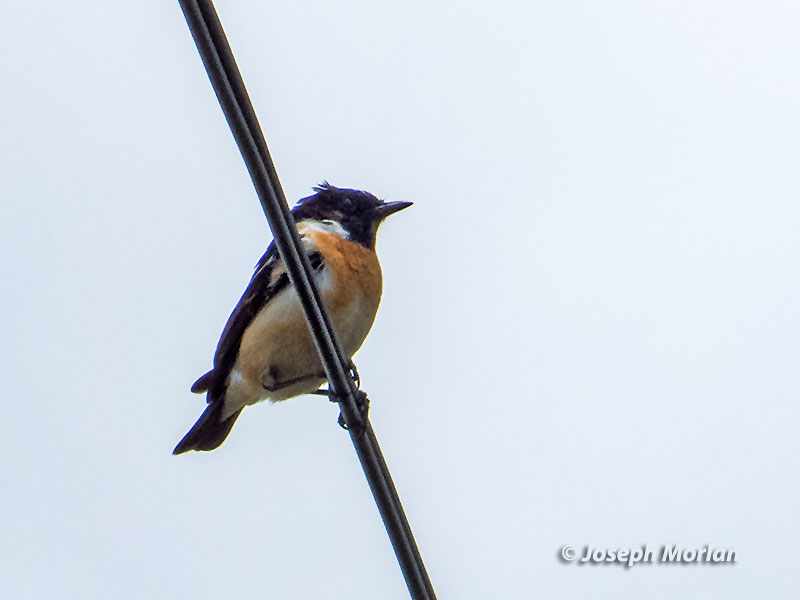
This is a male. These birds often sit in the open, upright on fences or small shrubs. The former Common Stonechat
(Saxicola torquatus) has been split into three species, European Stonechat (Saxicola rubicola), Siberian
Stonechat (Saxicola maurus), and African Stonechat (Saxicola torquatus), based on a series of phylogenetic
analyses of DNA sequence data (reviewed by Sangster et al. 2011). Within the reconstituted Siberian Stonechat,
there are five subspecies which Clements divides further into three groups: Siberian, Przewalski's, and Stejneger's.
Based on range, our bird should be Stejneger's which regularly breeds in Northern Japan. This individual has the
white lower belly, typical of the Siberian Group. As with other members of the subfamily Saxicolinae, most authors
now include them with the Muscicapidae (Old World Flycatchers) instead of the Thrushes (Turdidae) where formerly
placed..
This form is often split (e.g. IOC) as a separate species, Stejneger's Stonechat (Saxicola stejnegeri), but here I follow the latest Clements and treat it as a race of Siberian Stonechat. Saxicola maurus (incl ssp variegatus). Here is what Urquhart & Bowley 2002 say about the differences between Stejneger's and other races of Siberian Stonechat.
- Very similar in plumage detail and size to maurus, often impossible to separate in the field. c15% wider base to bill.
- Adult male breeding: virtually identical to maurus but variably shows less white on rump/uppertail-coverts; rufous on breast slightly more extensive.
- Adult male non-breeding: fringes to upperpart & underpart feathers darker rufous than maurus (more apparent in E of range).
- Female: virtually identical to maurus.
Additional information on distinguishing stejnegeri from maurus is here. Interestingly, Zink et al 2009 showed that maurus and stejnegeri are not even each others closest relatives (thus the treatment of stejnegeri as a full species by some authors).
References:
Collar, N. (2017). Common Stonechat (Saxicola torquatus). In: del Hoyo, J., Elliott, A., Sargatal, J., Christie,
D.A. & de Juana, E. (eds.). Handbook of the Birds of the World Alive. Lynx Edicions, Barcelona. (retrieved
from http://www.hbw.com/node/58515 on 18 June 2017).
Moores, N. (2014). Stejneger’s Stonechat in Korea: A Quick Introduction with Images. (retreived from http://www.birdskorea.org/Birds/Identification/ID_Notes/BK-ID-Stejnegers-Stonechat.shtml on 18 June 2017)
Sangster G., Collinson M., Crochet, P.-A., Knox A.G., Parkin D.T., Svensson L., Votier, S.C. (2011): Taxonomic recommendations for British birds: seventh report. Ibis 153: 883-892.
Urquhart, Ewan & Bowley, Adam (2002): Stonechats. A Guide to the Genus Saxicola. Christopher Helm, London.
Zink, R.M., Pavlova, A., Drovetski, S., Wink, M. & Rohwer, S. (2009) Taxonomic status and evolutionary history of the Saxicola torquata complex. Mol. Phylogenet. Evol. 52(3): 769–773.